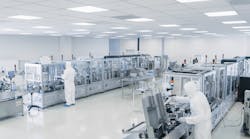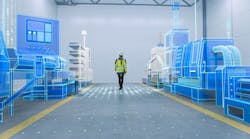[Solutions Spotlight] Stop the stall: The time is now for predictive maintenance in pharma
Predictive maintenance can help pharma companies can capture enormous value. Digital solutions can help eliminate downtime, reduce maintenance costs and maximize productivity, ultimately unlocking the capacity that is necessary to get the highest quality product to patients who need them most. Senior editor Andrea Corona discusses this with Zach Gilulah, pharma machine health lead at Augury.
Transcript
Andrea Corona: Pharma’s digital strategy starts with machines. By integrating predictive maintenance in their wider digital maintenance ecosystems, pharma companies can capture enormous value. Digital solutions help eliminate downtime, reduce maintenance costs and maximize productivity. Ultimately, this leads to unlocking the capacity that is necessary for the industry to get the highest quality product to patients who need them most.
I'm Andrea Corona, senior editor for pharma manufacturing magazine, and you're listening to a special Solutions Spotlight edition of off script of pharma manufacturing podcast about what's happening behind the scenes in our magazine and what's trending in the drug industry. Joining me today to talk about this is Zach Gilulah, pharma machine health lead at Augury. Zach has spent his entire career sharing his passion for technology and solving challenges that drive top and bottom-line results across a number of industries.
Welcome, Zach. And thank you for being here.
Zach Gilulah: Thanks for having me, Andrea.
Andrea: Of course. I'm sure you're very busy. So, let's go ahead and get started with the first question here. When we say maintenance strategies in manufacturing, what exactly does that entail?
Zach: Yeah, so generally speaking, we're talking about the systems process and people that are involved with bringing our products to market, especially in pharma, whether you're big pharma or CDMO, you know, pharmaceuticals are very unique in terms of how we make the products and we're really focusing on avoiding machine failure, so we could increase capacity in revenue, decrease costs, really look to optimize assets. And as you get under that first layer when we talk about pharmaceuticals or, or biotechnology therapeutics, there's just a lot of different processes, oral and liquid-solid dose, cell and gene, small and large molecules. So, you know, we talk about maintenance in a general sense, cause a lot of the equipment that are involved on the manufacturing floor, in the utilities or the facility equipment that supports those processes can be very similar, but all looking to make sure that we're reducing risk across the supply chain and from a financial sense as well.
Andrea: And how would you characterize the typical maintenance strategy in today's pharma plants?
Zach: Yeah, so, I'm lucky enough to be able to speak with a lot of different roles and companies in this space. And when we, we talk about what they're doing today, a lot of maintenance and reliability teams, a lot of manufacturing teams, it's a very manual process when we talk about their maintenance strategies. So it's manually checking equipment, using different styles of predictive maintenance or preventative maintenance. But it's calendar based, almost like our cars. You know, we're supposed to go change our oil every 3,000 miles, but you don't know if you actually need to, maybe our engines are still running and the oil's good. So, we're moving away from just allocating our resources. That's from a maintenance standpoint, whether it's calendar based or based on OEM recommendations or using third parties even, which is pretty prevalent in pharmaceuticals.
Andrea: And do you think pharma is lagging behind under other industries? And if you do think this, why do you think that is?
Zach: Yeah, so I mean, pharma is additionally unique cuz we are in a very, very, he heavily regulated industry, and we have to be compliant up and down our process. You know, ultimately our products are going to patients that it could be life-threatening illness that we're we are providing products for. So, in terms of lagging, it's an interesting way to phrase it, but the, the industry is very, very risk averse. So, when we look at new technologies and innovation, there's a lot of waiting and seeing to prove the value of a specific technology solution. And this all comes down to pharma because we're heavily regulated. There's so much data, so much paperwork and moving other aspects for electronic batch records or quality management systems, there's so much data that is generated from the processes that we have to make sure that it makes sense, to not impact anything other than positive impacts so that we could continue to bring products to the patients. The patient needs to be at the center. When we say kind of lagging behind, it makes sense in the way that again, it has to be vetted out and any type of technology really needs to do what it says it can do because of the importance.
Andrea: So, I guess this is a perfect segue into talking more about this shift to predictive maintenance and what that looks like for pharma. Can you tell me more about the role that data and technology play in all of this?
Zach: Yeah, so I was just at a biomanufacturing conference last week, and a lot of the supply chain leaders when talking about, what has happened the past couple years with COVID and where they were stress tested. A lot of this came down to trying to understand what the data that they have and how they can contextualize it to take action around. You know, there's a lot of technologies out there that talk about AI and machine learning and insights, but it it's really about the insights and taking action on the the data that you have and in pharma, where we're trying to source raw materials and produce them on the manufacturing lines, it comes down to the machines that support this product. So, that's, that's where the predictive maintenance piece, vibration analysis, so on and so forth. It's really important to focus on getting access to that data, so that you could take the right actions, to be more efficient with your human and capital resources.
Andrea: So, then the next question touches upon how people are still important as pharma's maintenance ecosystems become more reliant on smart systems and automation. I guess you just touched upon it with that answer, but what other thoughts might you have concerning the importance of people as pharma grows more reliant on automation and these smart systems.
Zach: Yeah. again, people are at the center of this. Technology is only as good as the people you have. So, when you're looking at opportunities to be more innovative, if as you may say you know, it comes down to making sure that the people involved are enabled to do their jobs in a more efficient way. And when we're talking about maintenance, a lot of maintenance reliability professionals are spending a ton of time trying to understand what they should be doing. Where are the failures happening? Can we get ahead of it? And most of the time, like I said, it's all reactive. You're getting a call, at 5:00 a.m. on a Saturday that a machine that's supporting a batch process went down, and that might be a vaccine for someone that desperately needs it. So, it's upskilling the people involved. It's making sure that they're not bringing waste in the process, you know, a lot of lean thinkers out there, but it's also the automation piece, and we touched on it a little bit, but it's, this whole supply chain is an ecosystem. People are driving the ecosystem, you have technologies like predictive maintenance technologies and ERPs and CMMS systems. All of that drives into kind of that overall picture and the goal of putting the patient at the center, so we could bring our products reliably to people that need them.
Andrea: So, as companies look to manufacturing operations to achieve these efficiency goals, how are they benchmarking manufacturing performance?
Zach: Yeah, it's a really interesting question, and probably a multifaceted answer. Benchmarking in pharma is difficult. There's a lot of nuance with each plant. CDMOs, depending on the sponsors that they are working with could be manufacturing a number of different types of modalities in their facilities, but we talk about benchmarking. Mckinsey has POBO, which is a well-known benchmarking system. I've talked with a lot of different people who are use their own criteria of success or metrics like OEE or a profit or plant throughput. But it really comes down to each individualized site. It all comes down to data. A lot of the conversations I have, everyone's trying to innovate, but they're nervous that they don't know how to measure success, or if they're doing better than another plant in the portfolio. You need to have the data to be able to compare moving forward, and that's where a lot of people look at predictive prescriptive maintenance to understand what, what good looks like. And I work with a lot of different people who start comparing machines in similar manufacturing lines in the same plant or across different continents, but until you have that machine layer data, the mechanical data that helps you understand what actions to take and how you should be designing your goals and what success looks like, like I said, it's pretty difficult to benchmark.
Andrea: So, in terms of looking ahead for our final question, as well, what are some of the potential positive, long-term benefits of predictive maintenance for the pharma industry?
Zach: Yeah, so, I mean from my perspective the foundational piece of a digital strategy starts with machines. If you think about how we bring our products to the market, there are critical points of the supply chain that are supported by machines. And when we look at the long-term benefits of being more efficient, avoiding failures, machine failures, we're being more efficient with spare parts programs, we're being more efficient with the people we have on staff and upscaling or attracting talent in this, in this tough environment. All of this leads to unlocking the capacity that is necessary for all companies in this industry to get the product to market, to get the product at the highest quality to the patients that need it. We didn't touch a lot on quality, but all of this is directly related. We see the headlines of, of vaccines that are recalled or manufacturing processes that hurt specific products that are being brought to market. That's all related to what we believe is machine health and the predictive maintenance piece, the prescriptive maintenance piece. It's the data that lives within that, that really allows the market leaders and the companies that are looking to innovate to set themselves up for long-term success from a maintenance and reliability standpoint, but really a digital and ultimately a patient outcome.
Andrea: Well, it sounds like you're definitely doing some really important work over there at Augury, and you have some really exciting things going on. So I look forward to hearing about this, thank you so much for joining me today and sharing your insights on the importance of predictive maintenance in pharma with our audience.
Zach: My pleasure, thanks for having me
Andrea: Thanks to you. This is Andrea Corona, and you've been listening to a special edition of Off Script: A Pharma Manufacturing Podcast. Stay healthy and stay informed.
For more, tune into Off Script: A Pharma Manufacturing Podcast.





